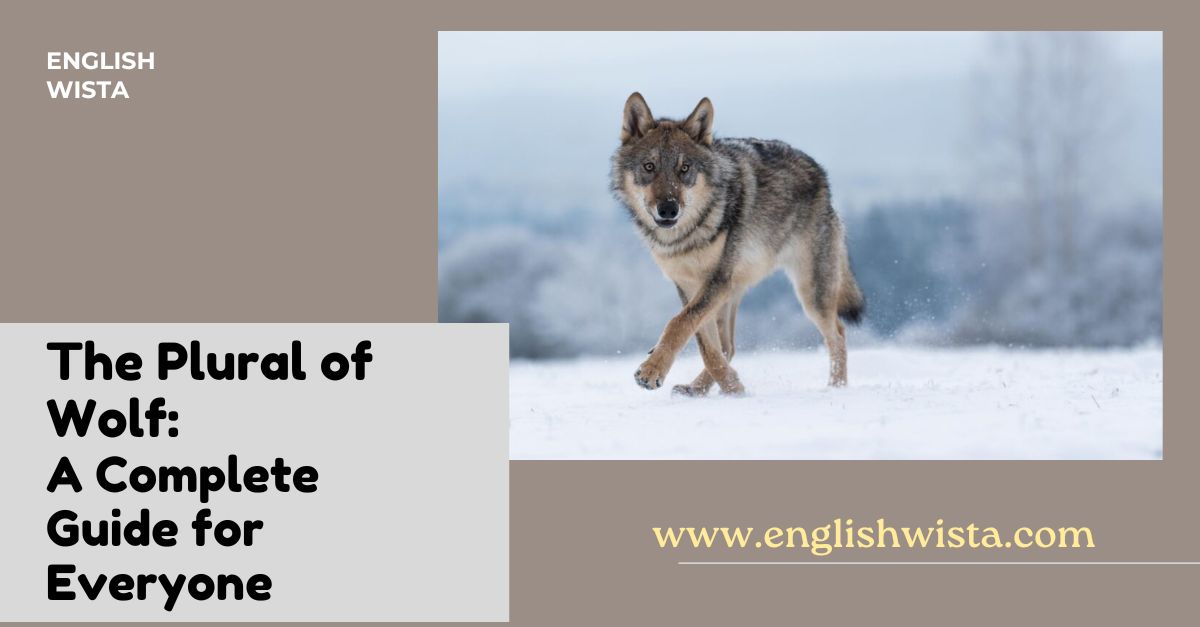Have you ever paused while writing or speaking and thought, “Wait… what’s the plural of wolf?” Don’t worry you’re not alone. English can sometimes play tricks on us, especially with words that don’t just add an “s” at the end. The word wolf is one of those sneaky ones that trips people up.
In this article, we’ll explore the plural of wolf step by step. We’ll keep things simple, friendly, and fun so you can easily remember the answer. Along the way, we’ll look at examples, clear up common confusions, dive into the word’s history, and even explore a few fun facts about wolves in language and culture. By the end, you’ll never doubt yourself again when it comes to the plural form of this fascinating animal.
So grab a cup of tea (or coffee if you prefer) and let’s take a closer look at the plural of wolf.
What is the Plural of Wolf?
The plural of wolf is wolves.
Instead of just adding an “s” like we do with many English nouns (for example, dog → dogs or cat → cats), wolf changes the “f” at the end to “v” and then adds “es.”
- Singular: wolf
- Plural: wolves
This same rule applies to other words that end in “f” or “fe,” such as:
- knife → knives
- life → lives
- calf → calves
So the pattern is: change the f to v, then add es.
Why Does Wolf Change to Wolves?
You might be wondering, “Why can’t it just be wolfs?” That would be so much easier, right?
The answer has to do with the history of English. Many English words come from Old English, which had its own grammar rules. Over time, these rules changed, but some of them stuck around. Words ending in “f” often followed the rule of changing to “v” in the plural. That’s why we have wolves instead of wolfs.
Not every “f” word follows this rule, though. For example:
- roof → roofs (not rooves)
- cliff → cliffs
So it’s one of those cases where English asks us to simply memorize the correct plural.
Is Wolf Singular or Plural?
This one’s easy: wolf is singular, and wolves is plural.
Think of it like this:
- If you see one animal, you say: I saw a wolf.
- If you see more than one, you say: I saw three wolves.
Simple enough once you know the rule!
Example Sentences with Wolf and Wolves
Let’s make it real with some examples. Notice how the sentence changes depending on whether we use wolf or wolves.
- A wolf howled at the moon last night.
- Several wolves were spotted near the forest.
- The legend speaks of a lone wolf who roams the mountains.
- The pack of wolves worked together to hunt.
- My favorite animal is the wolf.
- Scientists are studying the behavior of gray wolves.
By practicing with sentences, you’ll quickly get comfortable using the right form.
Where Does the Word Wolf Come From?
The word wolf has deep roots in history. It comes from the Old English word wulf, which itself goes back to Proto-Germanic wulfaz. Across many languages in Europe, similar words exist because wolves were common in ancient times and often part of folklore.
For example:
- German: Wolf
- Dutch: wolf
- Swedish: varg (though ulv is the older word, related to wolf)
- Latin: lupus (a different root, but also used in many languages)
This shows that wolves were important creatures in many cultures, and the word has traveled through history almost unchanged.
Common Mistakes People Make
It’s easy to make mistakes when learning the plural of wolf. Let’s clear up a few:
- Saying “wolfs” instead of “wolves.”
This is the most common slip-up. Remember the “f → v” rule. - Mixing up wolf and wolves in sentences.
Some learners accidentally use “wolf” when they mean “wolves.” Always check if you’re talking about one animal or more. - Over-applying the rule.
Some students think every word ending in “f” changes to “v.” But as we saw earlier, words like roof and cliff just take “s.”
Other Words Like Wolf
It’s easier to remember the plural of wolf if you also learn other similar words. Here are a few:
- Elf → Elves
- Shelf → Shelves
- Half → Halves
- Thief → Thieves
- Leaf → Leaves
By grouping words together, your brain makes stronger connections. So when you think of wolves, you’ll also remember leaves, thieves, and elves.
What About Wolf as a Verb?
Here’s something fun: wolf isn’t only a noun. It can also be a verb in English.
To “wolf something down” means to eat it quickly and hungrily, just like a wolf would.
Examples:
- I was so hungry that I wolfed down my sandwich.
- He wolfed his dinner and asked for seconds.
In this case, the word is used differently, but it adds another layer of meaning.
Fun Facts About Wolves and Language
Let’s take a short break from grammar and enjoy some fun facts:
- A group of wolves is called a pack.
- In literature, the phrase “lone wolf” is used to describe someone who prefers to act alone.
- The expression “cry wolf” comes from Aesop’s fable The Boy Who Cried Wolf. It means to raise a false alarm.
- Wolves have inspired countless myths and stories, from werewolves to Native American legends.
So learning about the plural of wolf connects you not just to grammar but also to culture and history.
Quick Memory Trick
Here’s an easy trick to remember:
If it ends with “f” and it’s something alive (like wolf, elf, calf), there’s a good chance it turns into “ves.”
This isn’t a perfect rule, but it helps in many cases. When in doubt, check a dictionary but the more you practice, the easier it gets.
Review: Key Takeaways
Let’s recap what we’ve learned so far:
- The plural of wolf is wolves, not wolfs.
- The rule is: change the “f” to “v” and add “es.”
- Wolf is singular, wolves is plural.
- Some “f” words follow this rule, but not all.
- Example: The wolf is hunting. The wolves are hunting.
- A group of wolves is called a pack.
Practice Time: Can You Spot the Correct Word?
Here’s a little practice for you. Which of these sentences are correct?
- The wolfs are howling in the night.
- Wolves live in packs.
- A lone wolf was spotted by the river.
- The hunter saw three wolfs.
Answer:
- Sentences 2 and 3 are correct.
- Sentences 1 and 4 should use wolves instead of wolfs.
Conclusion
English plurals can sometimes feel tricky, but once you learn the rule for a word, it becomes second nature. Now you know that the plural of wolf is wolves. Remember the simple rule: change the “f” to “v” and add “es.”
We also looked at examples, history, and even some fun wolf-related facts. Next time you’re writing a story, doing homework, or even just chatting with a friend, you’ll know exactly how to use wolf and wolves correctly.
So here’s the easy takeaway:
- One wolf.
- Many wolves.
That’s it simple, clear, and easy to remember.
And who knows? Maybe the next time you see wolves in a book or a movie, you’ll smile and think, “Ah, I know exactly why that’s the plural.”



